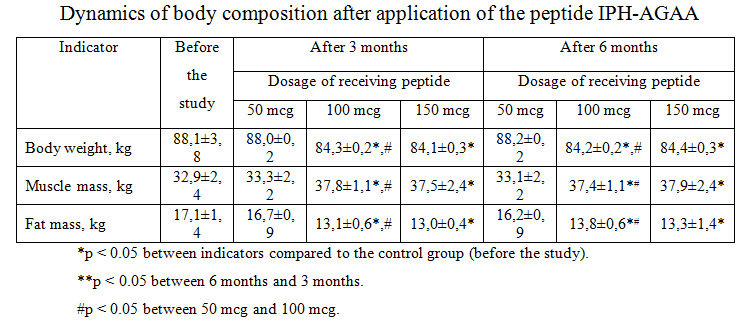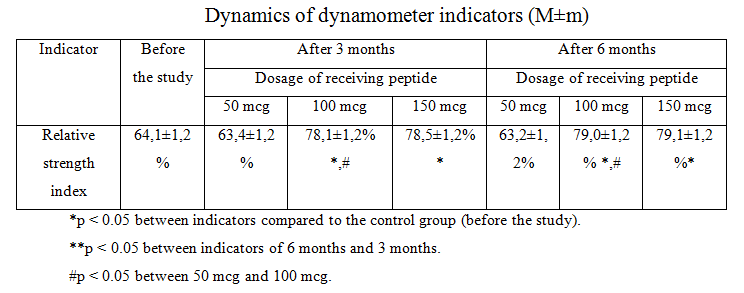Introduction
At the present time the study of the peptides’ properties [Dudgeon W. D. et others, 2016] has a high interest. Peptides have the same structure as proteins, but the size of these molecules is smaller. It is also important to note that short peptides, being a natural metabolic product present in the body, cannot be identified in blood or urine. In this case the study of the properties of individual structures can only be provided on cell cultures.
Peptide IPH-AGAA contains a low molecular weight peptide and has myoprotective properties as well as it has a normalizing effect on muscle tissue.
Experimental studies have shown that the peptide IPH-AGAA regulates metabolic processes in myocytes, increases the reserve capacity of the body, which suggests the effectiveness of the peptide IPH-AGAA to normalize the functions of the human muscular system in disorders of various origins.
Thus, the aim of the present research was to study of myoprotective and other peptide’s properties.
Clinical characteristics of patients
Clinical trials of the peptide IPH-AGAA were conducted in 77 relatively healthy men aged 30 to 58 years (mean age was 41.1±1.2 years).
Inclusion criteria: patients with compensated pathologies.
Exclusion criteria: acute diseases, patients with decompensate pathology, patients with exacerbation of chronic diseases.
To evaluate the effectiveness of the dose of 100 mcg (n=77 people) for the studied peptides, we conducted studies on the efficacy of peptides at a dose of 50 mcg (n= 75 people) and 150 mcg (n=76 people). The dose of 100 mcg per day for peptides is chosen as used in connection with the fact that according to the research of «St. Petersburg Institute of Biological regulation and gerontology» the effective dosage begins with 100 mcg, and the increase in the dosage does not affect the degree of effectiveness [Khavinson V. Kh., Linkova N. S., 2013].
Characteristics of the study
Peptide IPH-AGAA was administered orally according to the following scheme: 1 capsule (100 mcg peptide) 1 time per day for 30 days, then 30 days break — and repeat the same course for another 30 days, again break 30 days — and the third course for 30 days. The total course was 6 months (3 courses of 30 days and 3 breaks of 30 days).
All patients were engaged in adequate physical activity, as recommended by the World health organization in the Global recommendations on physical activity for health, namely: people should devote at least 150 minutes a week to aerobics of medium intensity. Each aerobics class should last at least 10 minutes. Power exercises, where the main muscle groups are involved, should be devoted 2 or more days a week
(https://www.who.int/dietphysicalactivity/factsheet_recommendations/ru/).
The effectiveness of the improved management scheme for such patients using the IPH-AGAA peptide was evaluated after 3 and 6 months. The initial data obtained before the study were selected for the control values.
The efficacy of the peptide IPH-AGAA was evaluated on the basis of subjective sensations (via VAS – visual analogue scale), the dynamics of muscle mass (using a body composition Monitor BF508, OMRON, manufacturer: Omron (Japan), model: HBF-508-E) and indicators of the dynamometry (using the dynamometer Megatons ACD/6P-1000/6I-1). The relative strength index (IC) was calculated using the formula: IC= strength of the strongest hand/ body Weight x 100%. The norm for men is the figure of 65-80%.
Statistical data processing
Statistical analysis was carried out using the program STATISTICA 11. The statistical methods of data processing were based on the calculation of the mean absolute and relative values with the calculation of the average error; the significance of the differences between the two sets was estimated using the Student t criterion (the difference was considered reliable at t>2, p<0.05).
Research result
The results of the clinical study of the use of the peptide IPH-AGAA presents that in humans after 3 months the use of this peptide the subjective assessment of physical activity, energy and endurance is significantly improved in 1.5 times compared with the initial data (table 1).

It should be noted that the most positive reliable results were found in relation to the subjective assessment of physical activity, energy and endurance after 3 months and did not change after 6 months of use IPH-AGAA peptide.
We have not found any significant differences between the parameters at 100 mcg and 150 mcg for all the studied parameters, which proves the fact that with an increase in the optimal dosage of the peptide used, the efficiency does not increase both after 3 months and after 6 months.
We also found no significant differences between the indicators in the application of 50 mcg and before the study on all the studied parameters, which proves the fact that the effective optimal dosage for peptides is 100 mcg.
The dynamics of body composition (muscle and fat mass) is presented in table 2.

An important fact is the significant decrease in total weight, increase in muscle mass in 1.1 times and a decrease in fat mass in 1.3 times after the use of the peptide IPH-AGAA compared to the baseline, p<0.05 between the indicators compared with the control group (before the study), p<0.05 between the indicators after 6 months and 3 months, which indicates the peptide properties in terms of normalization of cervical tissue functions and redistribution of muscle mass, that is a change in the body position.
We have not found any significant differences between the parameters at 100 mcg and 150 mcg for all the studied parameters, which proves the fact that with an increase in the optimal dosage of the peptide used, the efficiency does not increase both after 3 months and after 6 months.
We also found no significant differences between the indicators in the application of 50 mcg and before the study on all the studied parameters, which proves the fact that the effective optimal dosage for peptides is 100 mcg.
It should be noted that the use of the peptide IPH-AGAA significantly improves the performance of dynamometry in 1.2 times compared to the original data. Indicators after 3 months of use of the peptide IPH-AGAA reach the upper limit of the norm. While the baseline refers to a lack of muscle strength (below the lower limit of normal). The data are given in table 3.

We have not found any significant differences between the parameters at 100 mcg and 150 mcg for all the studied parameters, which proves the fact that with an increase in the optimal dosage of the peptide used, the efficiency does not increase neither after 3 months nor after 6 months.
We also found no significant differences between the indicators in the application of 50 mcg and before the study on all the studied parameters, which proves the fact that the effective optimal dosage for peptides is 100 mcg.
Thus, according to clinical data, the use of the peptide IPH-AGAA optimizes metabolism in muscle cells, improves microcirculation in muscle tissue, provides intensive and long-term nutrition of muscle cells, has a stimulating effect on muscles in hypoxia and increases the elasticity and elasticity of muscles.
Conclusion
Thus, the use of the peptide IPH-AGAA significantly improves the subjective assessment of physical activity, energy and endurance in 1.5 times, significantly increases muscle mass in 1.1 times and reduces fat mass in 1.3 times, which indicates the properties of this peptide in terms of normalization of muscle tissue functions and redistribution of muscle mass, that is, changes in body composition.
The use of the peptide IPH-AGAA significantly improves the parameters of Dinamometry in 1.2 times compared to the initial data. Indicators after 3 months of use of the peptide IPH-AGAA reach the upper limit of the norm. Therefore, according to clinical data, the use of the peptide IPH-AGAA optimizes metabolism in muscle cells, improves microcirculation in muscle tissue, provides intensive and long-term nutrition of muscle cells, has a stimulating effect on muscles in hypoxia and increases the elasticity and elasticity of muscles.
The use of peptide IPH-AGAA recommended in the form of a biologically active food supplement with therapeutic and preventive purposes for the normalization of the system functions of muscles.
Literature
- Linkova N. S., Drobantseva A. O., Orlova O. A., Kuznetsova E. P., Polyakova O. V., Kvetnoy I. M., Khvinson H. Kh. Peptide regulation of functions of skin fibroblasts upon aging in vitro // Cell technologies in biology and medicine. – 2016. — №1. P 40-44.
- Khavinson V. Kh. Peptide regulation of aging. SPb.: Science, 2009. — 50 p.
- Khavinson V.Kh., Kuznik B. I., Linkova N. S., Pronyaeva V. E. The Influence of peptide regulators and cytokines on life expectancy and age-related changes in the hemostatic system. // Advance of physiological Sciences 2013. Vol. 44. No. 1. P 39-53.
- Kathryn R Wagner, MD, PhD and Julie S Cohen, ScM, CGC. Myostatin-Related Muscle Hypertrophy// National Center for Biotechnology Information, U.S. National Library of Medicine- 2018.- № 4- p.35-39.




